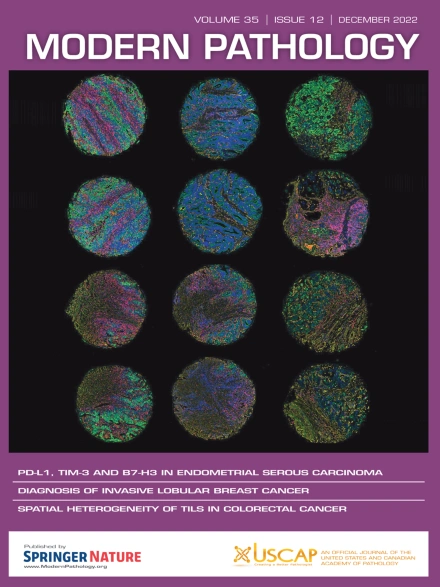Revisiting Hepatic Small Vessel Neoplasms and Anastomosing Hemangiomas as a Unique Capillary Liver Neoplasm: A 25-Case Series With Pathomolecular Correlations
IF 7.1
1区 医学
Q1 PATHOLOGY
引用次数: 0
Abstract
Hepatic small vessel neoplasm (HSVN) and anastomosing hemangioma (AH) are 2 capillary liver neoplasms that are challenging to differentiate in clinical practice. This study aimed to refine their classification through integrated histopathologic and molecular analyses. We conducted a bicentric retrospective study of 25 cases (15 resections and 10 biopsies). Four liver pathologists (A.B., A.L.B., V.P., C.G.) independently reviewed histologic and immunohistochemical features. Targeted DNA next-generation sequencing and RNA sequencing were performed on 21 and 15 cases, respectively. Seven lesions (28%) were diagnosed as AH, presenting as well-demarcated tumors with fibrotic stroma, often associated with cirrhosis (5/7, 71%). The remaining 18 lesions (72%) were identified as HSVN, typically infiltrative and occurring predominantly in noncirrhotic livers (78%). Microscopically, HSVN displayed 2 distinct patterns: (1) a classic pattern (8/18, 44%) composed of small, thin–walled vessels and (2) a hepatocellular-reactive pattern (7/18, 39%) with small vessels interwoven with regenerative hepatocellular trabeculae. A mixed pattern appeared in 3 of 18 cases (17%). No cytologic atypia or mitoses were observed. Tumor cells consistently expressed ERG, CD31, and CD34, with Ki67 indices <10% in all cases. Mutations in GNA genes were found in 20 of 21 cases (95%), distributed between GNA14 (81% overall: 4 AH and 13 HSVN, P = .544) and GNAQ (19% overall: 2 AH and 2 HSVN, P = .544). Transcriptomic analysis revealed no differentially expressed genes between AH and HSVN. After a median follow-up of 18 months, no recurrence was observed in resected tumors. Tumor growth was noted in 3 nonresected or partially resected cases (2 AH and 1 HSVN). In conclusion, despite subtle pathological differences, HSVN and AH exhibit overlapping clinical and molecular features, supporting their reclassification as a single benign entity, namely AH. Notably, some lesions exhibit a hepatocellular-reactive pattern that closely mimics hepatocellular adenoma, posing a significant diagnostic challenge, particularly in biopsy specimens.
重新审视肝小血管肿瘤和吻合血管瘤作为一种独特的毛细血管肝脏肿瘤:25例病理分子相关性。
肝小血管瘤(HSVN)和吻合性血管瘤(AH)是两种在临床实践中具有挑战性的毛细血管肿瘤。本研究旨在通过综合组织病理学和分子分析来完善其分类。我们对25例病例进行了双中心回顾性研究(15例切除和10例活检)。四位肝脏病理学家独立审查了组织学和免疫组织化学特征。分别对21例和15例患者进行了靶向DNA下一代测序和RNA测序。7个病变(28%)被诊断为AH,表现为界限清晰的肿瘤伴纤维化间质,常伴有肝硬化(5/ 7,71%)。其余18个病变(72%)被确定为HSVN,通常是浸润性的,主要发生在非肝硬化肝脏(78%)。显微镜下,HSVN表现出两种不同的模式:(1)由小薄壁血管组成的典型模式(8/18,44%)和(2)小血管与再生肝细胞小梁交织的肝细胞反应型模式(7/18,39%)。3/18(17%)为混合型。未见细胞异型性或有丝分裂。肿瘤细胞一致表达ERG、CD31和CD34,并伴有Ki67指数
本文章由计算机程序翻译,如有差异,请以英文原文为准。
求助全文
约1分钟内获得全文
求助全文
来源期刊

Modern Pathology
医学-病理学
CiteScore
14.30
自引率
2.70%
发文量
174
审稿时长
18 days
期刊介绍:
Modern Pathology, an international journal under the ownership of The United States & Canadian Academy of Pathology (USCAP), serves as an authoritative platform for publishing top-tier clinical and translational research studies in pathology.
Original manuscripts are the primary focus of Modern Pathology, complemented by impactful editorials, reviews, and practice guidelines covering all facets of precision diagnostics in human pathology. The journal's scope includes advancements in molecular diagnostics and genomic classifications of diseases, breakthroughs in immune-oncology, computational science, applied bioinformatics, and digital pathology.
 求助内容:
求助内容: 应助结果提醒方式:
应助结果提醒方式:


